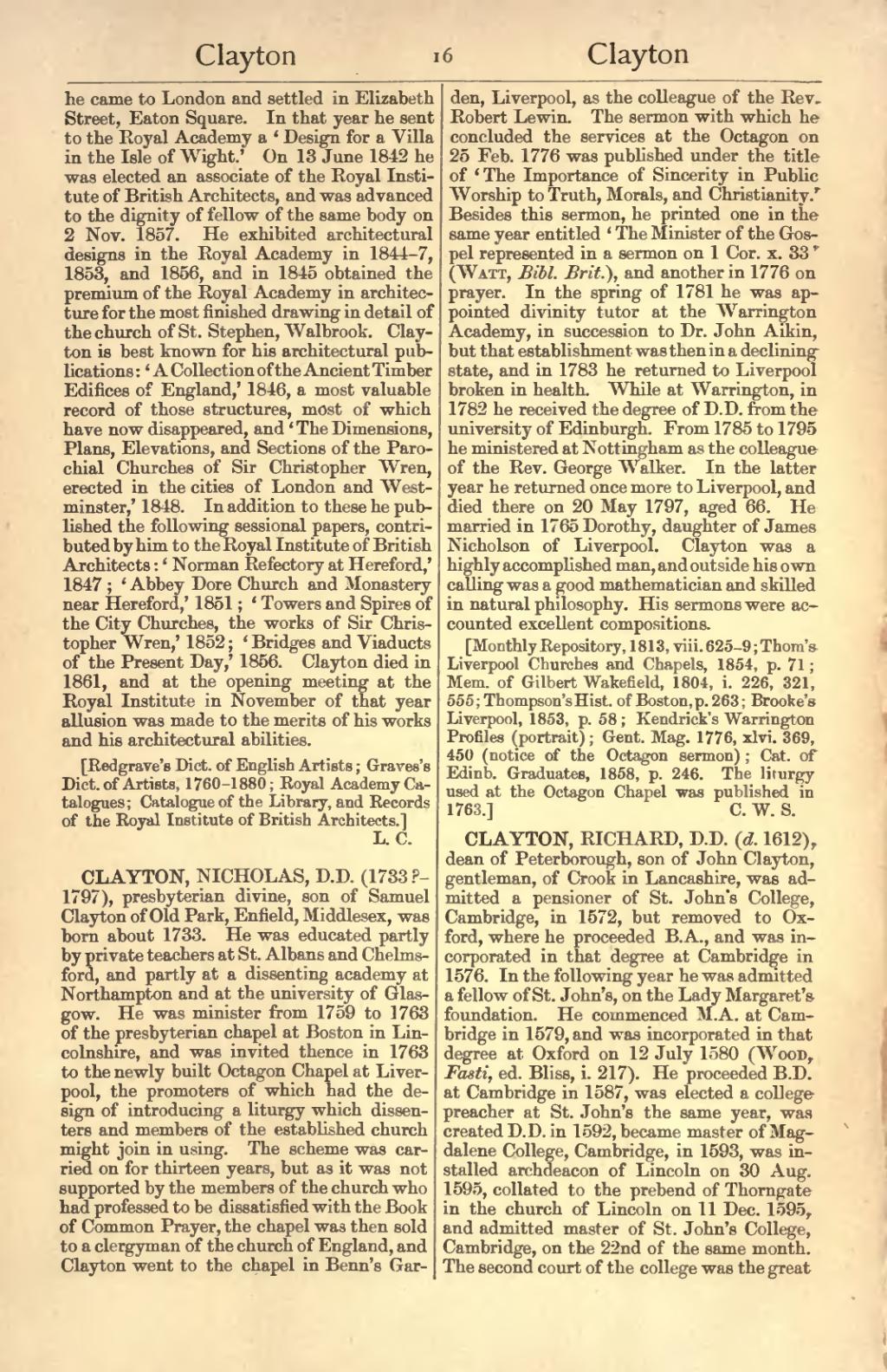he came to London and settled in Elizabeth Street, Eaton Square. In that year he sent to the Royal Academy a ‘Design for a Villa in the Isle of Wight.’ On 13 June 1842 he was elected an associate of the Royal Institute of British Architects, and was advanced to the dignity of fellow of the same body on 2 Nov. 1857. He exhibited architectural designs in the Royal Academy in 1844–7, 1853, and 1856, and in 1845 obtained the premium of the Royal Academy in architecture for the most finished drawing in detail of the church of St. Stephen, Walbrook. Clayton is best known for his architectural publications: ‘A Collection of the Ancient Timber Edifices of England,’ 1846, a most valuable record of those structures, most of which have now disappeared, and ‘The Dimensions, Plans, Elevations, and Sections of the Parochial Churches of Sir Christopher Wren, erected in the cities of London and Westminster,’ 1848. In addition to these he published the following sessional papers, contributed by him to the Royal Institute of British Architects: ‘Norman Refectory at Hereford,’ 1847; ‘Abbey Dore Church and Monastery near Hereford,’ 1851; ‘Towers and Spires of the City Churches, the works of Sir Christopher Wren,’ 1852; ‘Bridges and Viaducts of the Present Day,’ 1856. Clayton died in 1861, and at the opening meeting at the Royal Institute in November of that year allusion was made to the merits of his works and his architectural abilities.
[Redgrave's Dict. of English Artists; Graves's Dict. of Artists, 1760–1880; Royal Academy Catalogues; Catalogue of the Library, and Records of the Royal Institute of British Architects.]
CLAYTON, NICHOLAS, D.D. (1733?–1797), presbyterian divine, son of Samuel Clayton of Old Park, Enfield, Middlesex, was born about 1733. He was educated partly by private teachers at St. Albans and Chelmsford, and partly at a dissenting academy at Northampton and at the university of Glasgow. He was minister from 1759 to 1763 of the presbyterian chapel at Boston in Lincolnshire, and was invited thence in 1763 to the newly built Octagon Chapel at Liverpool, the promoters of which had the design of introducing a liturgy which dissenters and members of the established church might join in using. The scheme was carried on for thirteen years, but as it was not supported by the members of the church who had professed to be dissatisfied with the Book of Common Prayer, the chapel was then sold to a clergyman of the church of England, and Clayton went to the chapel in Benn's Garden, Liverpool, as the colleague of the Rev. Robert Lewin. The sermon with which he concluded the services at the Octagon on 25 Feb. 1776 was published under the title of ‘The Importance of Sincerity in Public Worship to Truth, Morals, and Christianity.’ Besides this sermon, he printed one in the same year entitled ‘The Minister of the Gospel represented in a sermon on 1 Cor. x. 33’ (Watt, Bibl. Brit.), and another in 1776 on prayer. In the spring of 1781 he was appointed divinity tutor at the Warrington Academy, in succession to Dr. John Aikin, but that establishment was then in a declining state, and in 1783 he returned to Liverpool broken in health. While at Warrington, in 1782 he received the degree of D.D. from the university of Edinburgh. From 1785 to 1795 he ministered at Nottingham as the colleague of the Rev. George Walker. In the latter year he returned once more to Liverpool, and died there on 20 May 1797, aged 66. He married in 1765 Dorothy, daughter of James Nicholson of Liverpool. Clayton was a highly accomplished man, and outside his own calling was a good mathematician and skilled in natural philosophy. His sermons were accounted excellent compositions.
[Monthly Repository, 1813, viii. 625–9; Thom's Liverpool Churches and Chapels, 1854, p. 71; Mem. of Gilbert Wakefield, 1804, i. 226, 321, 555; Thompson's Hist. of Boston, p. 263; Brooke's Liverpool, 1853, p. 58; Kendrick's Warrington Profiles (portrait); Gent. Mag. 1776, xlvi. 369, 450 (notice of the Octagon sermon); Cat. of Edinb. Graduates, 1858, p. 246. The liturgy used at the Octagon Chapel was published in 1763.]
CLAYTON, RICHARD, D.D. (d. 1612), dean of Peterborough, son of John Clayton, gentleman, of Crook in Lancashire, was admitted a pensioner of St. John's College, Cambridge, in 1572, but removed to Oxford, where he proceeded B.A., and was incorporated in that degree at Cambridge in 1576. In the following year he was admitted a fellow of St. John's, on the Lady Margaret's foundation. He commenced M.A. at Cambridge in 1579, and was incorporated in that degree at Oxford on 12 July 1580 (Wood, Fasti, ed. Bliss, i. 217). He proceeded B.D. at Cambridge in 1587, was elected a college preacher at St. John's the same year, was created D.D. in 1592, became master of Magdalene College, Cambridge, in 1593, was installed archdeacon of Lincoln on 30 Aug. 1595, collated to the prebend of Thorngate in the church of Lincoln on 11 Dec. 1595, and admitted master of St. John's College, Cambridge, on the 22nd of the same month. The second court of the college was the great
